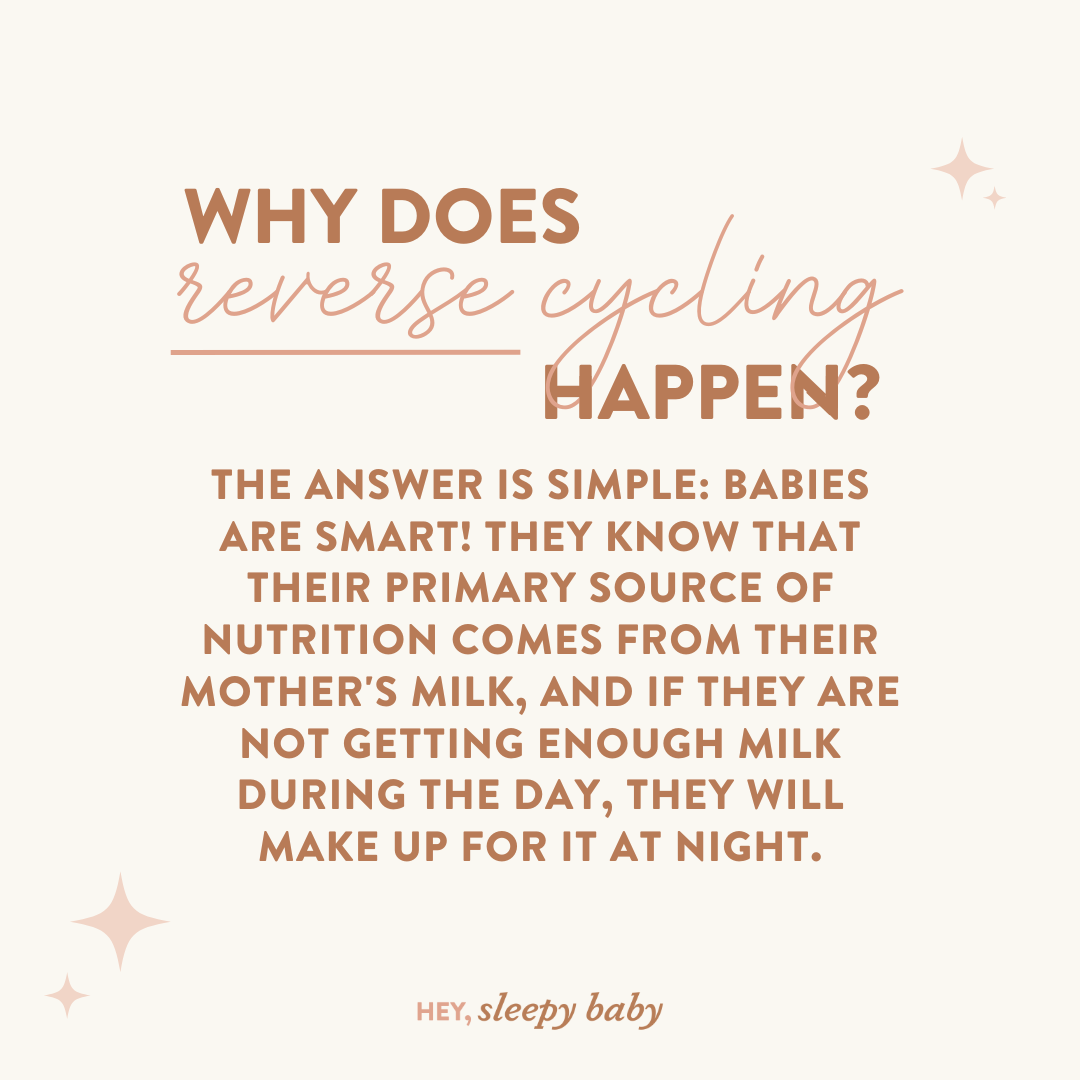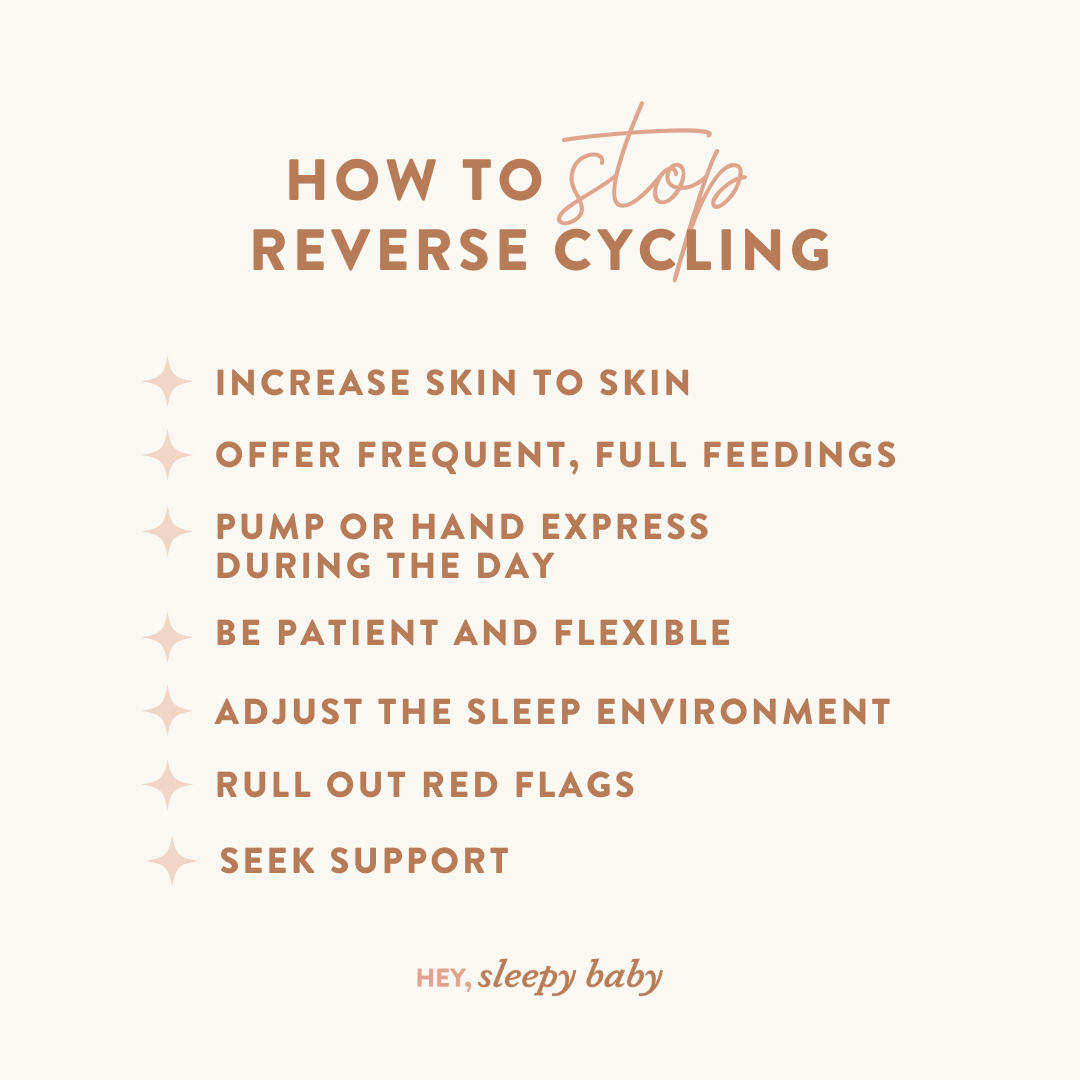I'm Rachael
Mom of 3 & Baby Sleep Expert with Big Sis Energy
& I’VE DONE ALL THE RESEARCH FOR YOU ALREADY.
Better sleep for the entire family
BROWSE COURSES
hey!
what is reverse cycling and how do i know if my baby is reverse cycling?
As a baby sleep consultant, I’ve worked with many new parents who have experienced a phenomenon known as “reverse cycling” babies. Reverse cycling in babies occurs when a breastfed infant begins to consume most of their 24-hour intake of milk during the night, rather than during the day. This can be a frustrating and exhausting experience for parents who are struggling to get their baby to sleep during the night. In this blog post, I will explain what reverse cycling is, why it happens, and how parents can cope with it.
is reverse cycling a real thing?
Reverse cycling IS a real thing and can actually be common among breastfed babies, especially those who are going through growth spurts or have experienced a change in their routine, such as starting daycare or their parents returning to work. According to a study published in the Journal of Human Lactation, reverse cycling can occur in up to 45% of breastfed babies during the first year of life (Flaherman et al., 2012). Why is this?

why does reverse cycling happen?
The answer is simple: babies are smart! They know that their primary source of nutrition comes from their mother’s milk, and if they are not getting enough milk during the day, they will make up for it at night. Additionally, breastfed babies often prefer to nurse for comfort as well as nourishment, and the quiet, dark environment of the nighttime can provide the perfect setting for this (Ball, 2016) especially as babies get older and more distracted during daytime feedings. Remember that it’s very normal for babies to feed at night, but reverse cycling is a phenomenon in which MOST feedings or ounces are being given at night rather than during the day.

Reverse cycling is also common in newborns, who don’t have an established circadian rhythm that keeps them awake in the day and asleep at night.
Babies sometimes reverse cycle during times of change, like the breastfeeding mother returning to work, baby starting childcare, or when traveling and outside the usual feeding routine.
Reverse cycling can sometimes happen because baby and mom are separated during the day, but also makes sense based on the natural regulation of supply. Milk volume is typically highest during the middle of the night/ early morning hours, usually between 1 am and 5 am, and gradually decreases throughout the day (Cobo-Armijo et al., 2018). This is likely due to the circadian rhythm of prolactin secretion, with higher levels of prolactin in the early morning hours.
It’s worth noting that milk volume can also be influenced by other factors, such as frequency and effectiveness of breastfeeding, hydration and nutrition, and overall milk supply. So, while milk production may be higher during certain hours of the day, it’s important for breastfeeding parents to feed their baby on demand and follow their baby’s cues for when they need to nurse or receive expressed milk. Offering as many opportunities for feedings during daytime hours can help your baby avoid being up all night to eat. If you have any concerns with your milk supply, contact an IBCLC right away.
how do you know if it’s reverse cycling or something else?
Sometimes it’s confusing to know if an uptick in night wakings or increase in overnight feeds is truly a reverse cycling issue or something else like teething or a sleep progression. Here are some things that might not be reverse cycling but are another issue causing your baby to wake more frequently:
-
bottle strike: maybe you’ve just introduced bottle feeding since you’ll be returning to work or bringing in another caregiver and your baby isn’t taking the bottle well yet. This can cause them to be up more at night to breastfeed.
-
teething or illness can cause your baby to be up more at night and/or wanting to feed more for comfort
-
a growth spurt or sleep progression may also cause increased night waking/ feeding but will likely be temporary
-
separation anxiety may also spike at certain points in development and your baby is waking more for extra closeness
-
A newborn that is reverse cycling means that they are very sleepy during the day and up to feed more at night. This day/ night confusion for newborns is very common and could lead to reverse cycling. Parents of newborns should aim to feed their baby every 2-3 hours during the day (yes- wake them up!) to help with day and night confusion and reverse cycling

what should you do about reverse cycling?
So how do you fix reverse cycling in your baby? If you have just returned to work and your baby is reverse cycling, it’s a good idea to physically connect with them and offer a feeding as soon as you are reunited. You might pick them up from daycare and nurse right then and there before you even drive home. Then you can offer again when home, with dinner, and at bedtime.
If you’re aware of a change in schedule or an especially busy time coming up, be sure to plan for feeding opportunities during the day. You may even set a timer or reminder on your phone or watch to remind you to offer more daytime feedings. Babywearing can also help facilitate feeding on the go.
Offering a dream feed is another possible solution to reverse cycling, as you want to get in as many feeds during your waking hours as possible. You can feed your baby right before you go to bed.
how to stop reverse cycling in babies
The first step is to make sure that your baby is getting enough milk during the day. If you are returning to work or your baby is starting daycare, make sure to communicate with your caregiver about your baby’s feeding needs and provide expressed milk if necessary. If you’re worried about your little one taking a bottle in your absence check out this blog post. Here are some other things you can try if your baby is stuck in the pattern of reverse cycling:
1. Increase skin-to-skin contact: Skin-to-skin contact has been shown to increase milk production in breastfeeding mothers and can help regulate a baby’s feeding patterns. So, try to incorporate more skin-to-skin time with your baby during the day, and consider doing a “nursing vacation” on the weekend, where you spend a few days in bed with your baby, offering frequent feedings throughout the day (Lawrence & Lawrence, 2016).
2. Offer frequent, full feedings during the day, and try to limit distractions during feeding times. Babies over 5-6 months tend to be more distractible during daytime feeds which can lead to reverse cycling. If this is your baby, try feeding in a low-stimulation environment like a dim room away from other people and noises. You may also try feeding right before sleep and right when they wake up from a nap, as this “drowsy” state may be when they are able to take the full feed.

3. Pump or hand express during the day: If you are away from your baby during the day, make sure to pump or hand express milk regularly to maintain your milk supply. Your little one may be reverse cycling because there is simply more milk overnight and in the early morning hours, so pumping or breastfeeding often during the day can help with this.
4. Be patient and flexible: Reverse cycling can be a frustrating experience, but it is important to remember that it is a temporary phase. Try to be patient with your baby and yourself, and be open to adjusting your sleep set up, routines and strategies as needed.
5. Another strategy is to adjust your baby’s sleep environment. Make sure that your baby’s sleeping area is dark, quiet, and cool, and consider using white noise to drown out any background noise. Additionally, try to establish a consistent bedtime routine that includes plenty of time for cuddling and bonding, especially if being away from your baby during the day is a potential reason for the reverse cycling.
6. Rule out red flags. You want to be sure baby isn’t up eating all night because they are inefficient feeders during the day due to something like an oral tie. If you’re concerned about your baby’s ability to breastfeed or you’re dealing with other symptoms during feeds like clicking sounds, gasping/ choking at the breast, reflux etc., and/or you’re experiencing supply dips, clogged ducts or mastitis etc. reach out to an IBCLC right away, and ask for a referral for a pediatric dentist who can look for oral ties.
7. Seek support: Finally, don’t be afraid to seek support from your partner, family, friends, or healthcare provider. Reverse cycling can be stressful and exhausting, but having a support system can help you navigate this challenging time. An IBCLC is an incredible resource to help with any breastfeeding issue, discuss pumping and bottle feeding or potential supplementation, etc. Vsits are usually covered by insurance.
In conclusion, reverse cycling is a common experience among breastfed babies, but it is not something that parents have to endure alone. By implementing these strategies and seeking support, parents can help their baby get back in sync to get the nourishment and rest they need, while also promoting a positive breastfeeding experience for themselves.
References:
Ball, H. L. (2016). Breastfeeding, bed-sharing, and infant sleep. Birth, 43(1), 4-5. https://doi.org/10.1111/birt.12222
Lawrence, R. A., & Lawrence, R. M. (2016). Breastfeeding: A guide for the medical profession. Elsevier Health Sciences.
Flaherman, V. J., Gay, B., & Scott, C. (2012). Parental perceptions of sleep disturbances and sleep-disordered breathing in breastfed infants. Journal of Human Lactation, 28(3), 317-324. https://doi.org/10.1177/0890334412440909
Was this helpful? Save it for later!

binge reads
We think you'll love these
You deserve to the
baby stage, not just "survive it."
And you DON'T have to sacrifice your values, ignore your instincts, or force yourself to follow a method you don't align with just to get your baby back to sleep.
I’m here to help you create a restful, sustainable sleep environment that honors both your baby’s needs AND your own (without the stress OR the guilt!) because, no, you don’t have to choose between the two.
enjoy!
BABY SLEEP COURSES →
BABY SLEEP CONSULTS →
Wish you could help your baby sleep better without resorting to sleep training? Download my FREE guide to a good night’s sleep and learn 8 simple, science-backed tips for supporting your child’s needs.
Traditional sleep training methods don’t have to be your solution to better sleep.
SLEEP TRAINING ISN’T THE ONLY WAY TO GET GOOD SLEEP
Hey, I'm Rachael and Hey, Sleepy Baby is for parents who want to get their nights back, without sleep training their babies.
NO ONE TOLD US POD
explorING the untold truths of parenting


